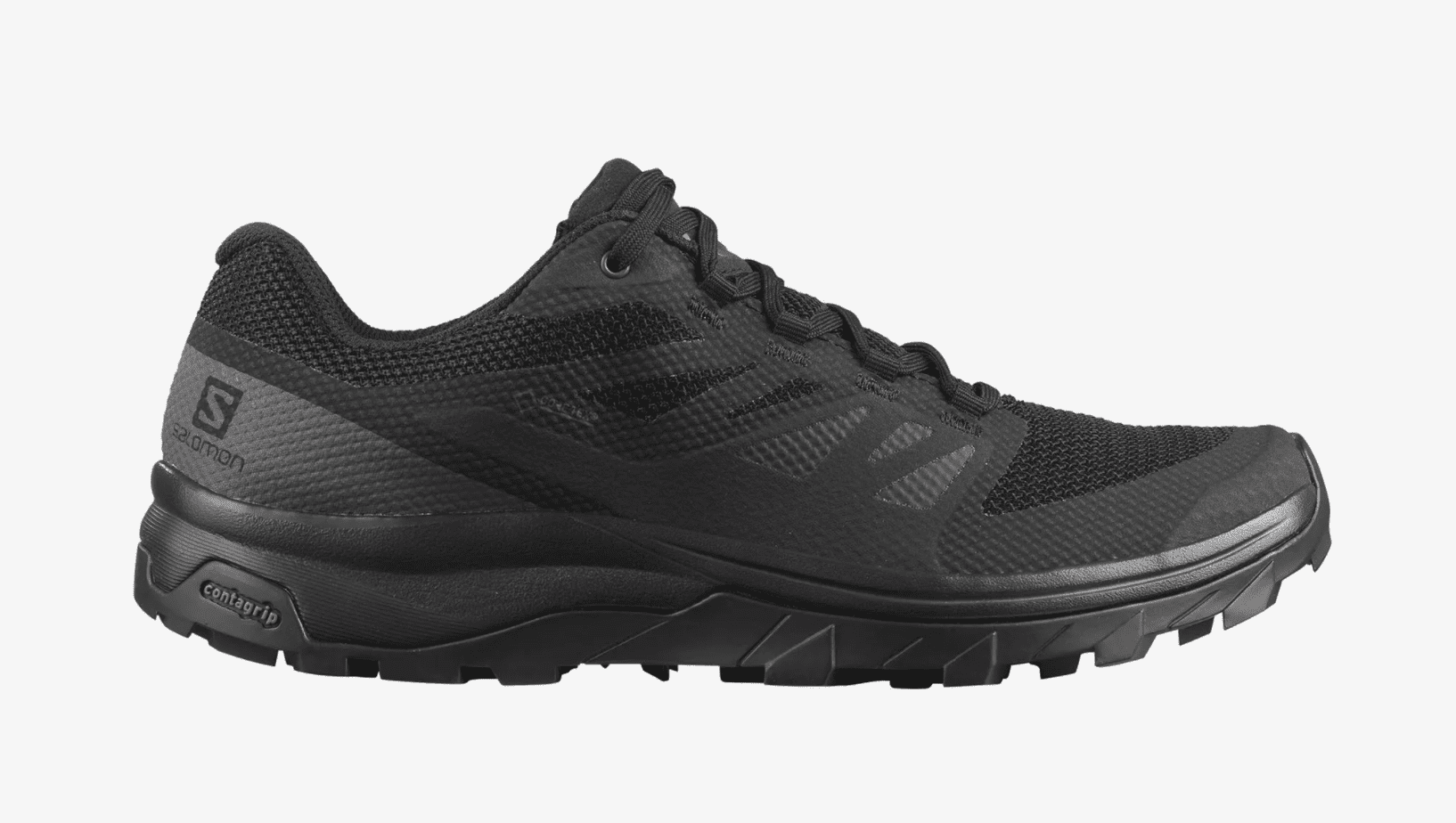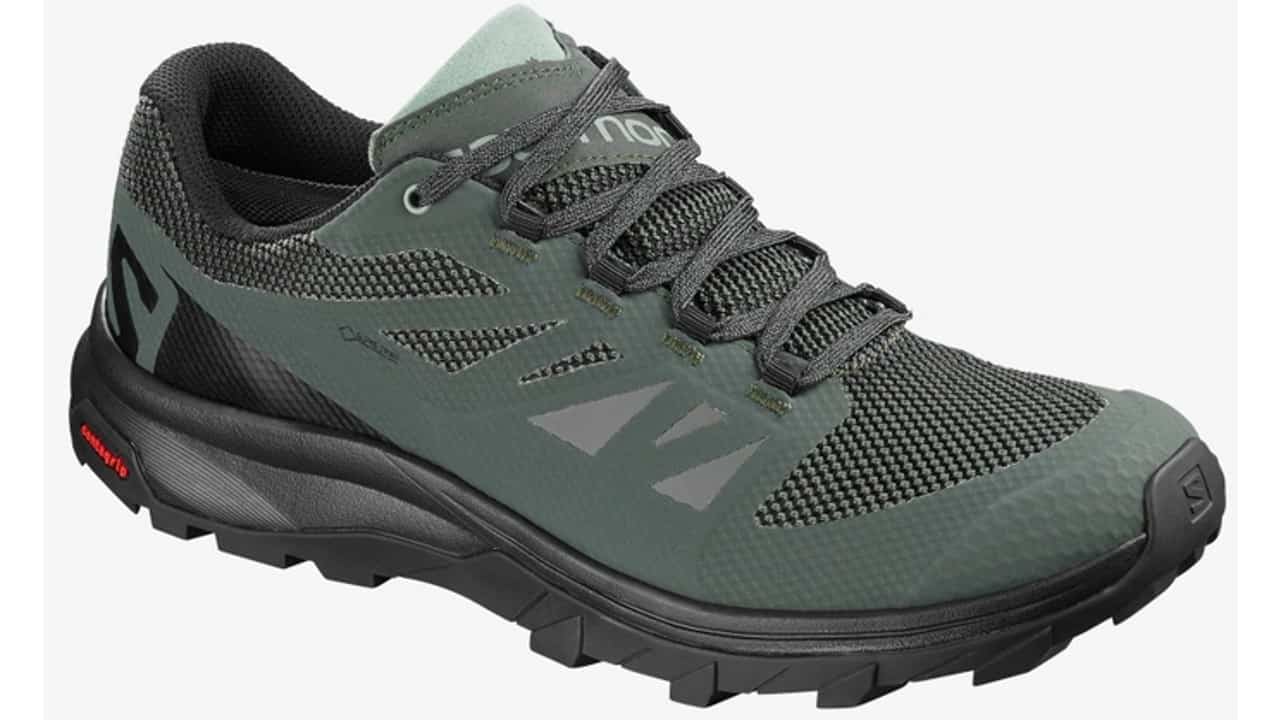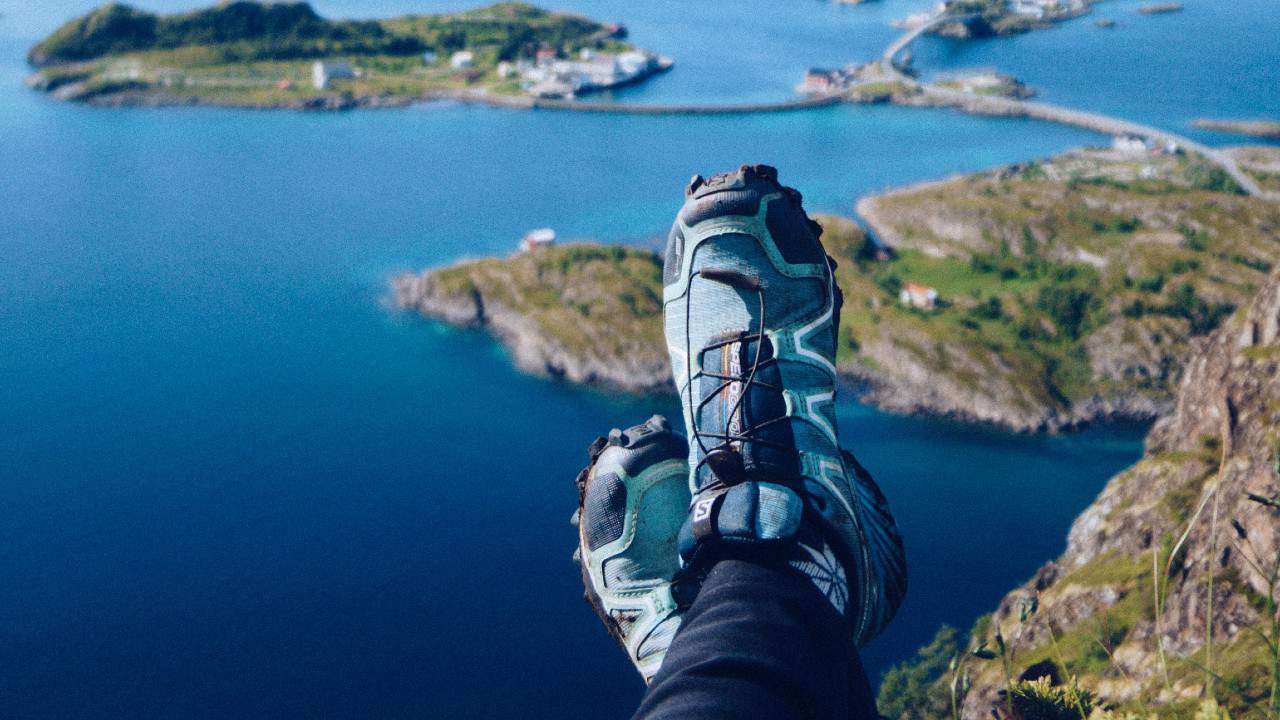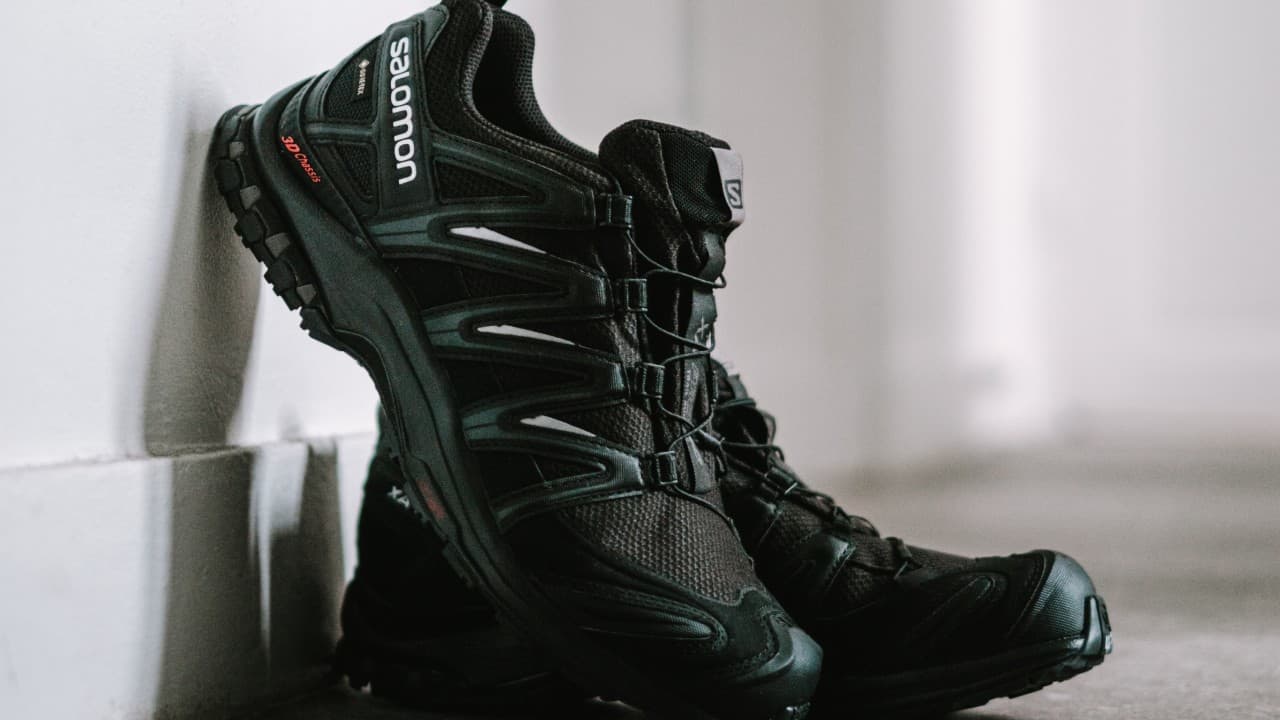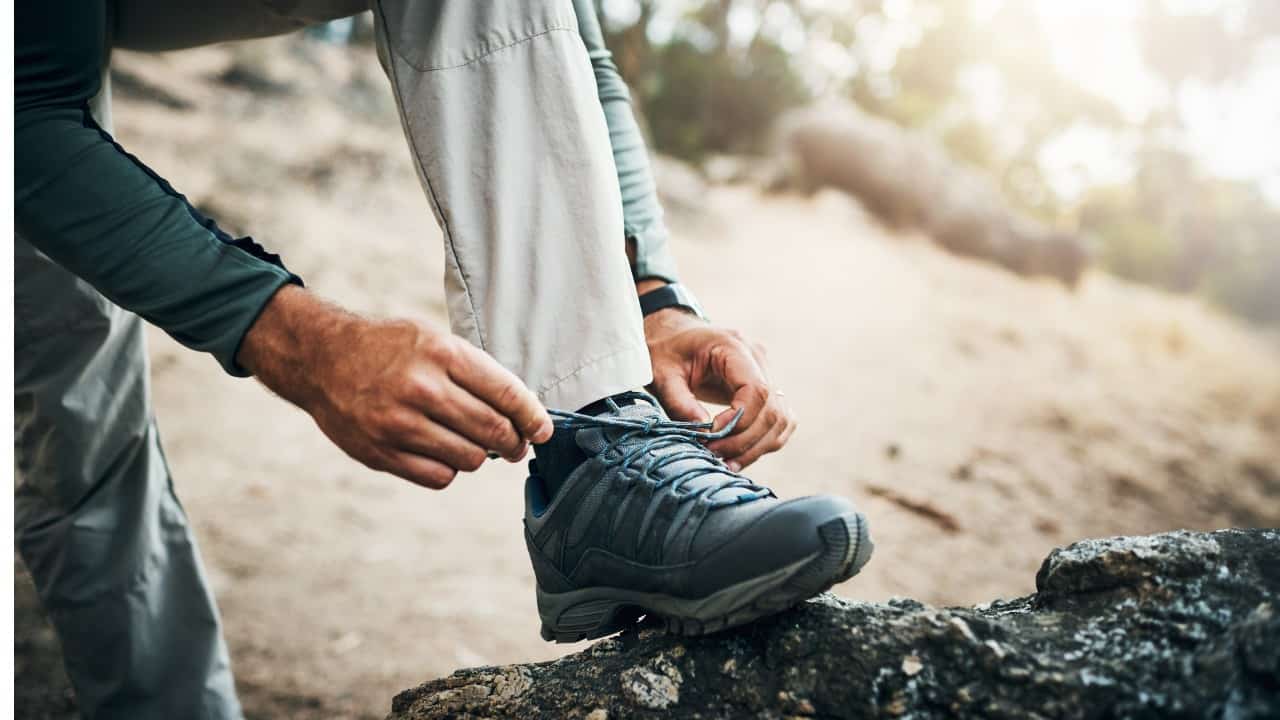As they mix the performance benefits of both low-top hiking shoes and trail runners, Salomon’s immensely popular Outline GTX shoes successfully mirror the modern trends.
The result of this mixture is a solid all-around performance and versatility that turn these Salomon shoes into an excellent option for trekking, trail running, paddling, as well as around-town use.
If you’ve been thinking about buying these hiking shoes for quite some time now, you’re in the right place. In this article, I’ll be taking a thorough look at these shoes and help you determine whether they’re the right hiking footwear choice for you.
The Overview
Salomon Men’s Outline GTX Trail Running Hiking Shoes
Specifications:
- Weight: 1.53 lbs
- Waterproof: Yes
- Colors Available: 3
A “jack of all trades”, this hiking/trail running combo from Salomon is popular for a good reason. It’s a modern, lightweight product that provides its owner with a running shoe-like feel but which can also be used for a wide variety of other outdoor activities, including hiking.
If you’d like to know more about how this shoe stacks up against its competitors in terms of comfort, weight, traction, water resistance, and many other things, keep reading. If you’ve no time to go through all the paragraphs, here are the main advantages and disadvantages of these shoes.
Pros
- Thoughtful design – a successful combo of a trail runner and a regular hiking shoe
- Lightweight, easy to use, and sleek construction with an everyday appeal
- Cheaper than the brand’s XA Pro 3D V8 and X Ultra 3 models
Cons
- A tad bit disappointing in terms of durability and comfort
The Review
Comfort
Out of all the Salomon hiking shoes I’ve ever tested, these were the ones with the most running shoe-like feel.
The ankle is cut noticeably low and the shoes are exceptionally light on the foot. When compared to the Quicklace laces found on other hiking shoes made by this brand, the flat laces on Outline Low GTX feel far less bulky.
The fit of this men’s shoe is a bit narrow (more on that later), especially in the toe box area. However, this can also be seen as an advantage – if you have low-volume feet, i.e. if your feet are particularly narrow, the Salomon Outline Low GTX shoes are an ideal option for you.
To determine how comfortable they actually are, I decided to test out these hiking shoes on the trail. During this simple 8-mile hike, I’ve noticed that the model has certain limitations, despite the fact that the trekking conditions were excellent and that the trail I hiked was wide and well-built (although with a bit of rough terrain in some sections).
By the end of the hike, my (higher-volume) feet felt tired. In other words, the trail impacted them more than I expected, especially after reading all the good stuff about Salomon Outline Low GTX online. The EVA midsole and the Ortholite insole did not provide as much cushioning as I expected.
An important thing to mention here is that I took the shoes straight from the box to the trail. It’s quite obvious that Salomon Outline GTX requires a gentler break-in period.
Furthermore, the fact that this is a truly lightweight shoe means that it doesn’t offer as much protection, cushion, and arch support as some other models made by Salomon, despite the fact that it features an Ortholite insole and an EVA midsole.
All in all, I’d say that Salomon Outline GTX is a good choice for moderate and short hikes. Using them for serious instead of light hiking is something I definitely wouldn’t recommend – especially if you don’t have narrow feet.
Fit & Sizing
As I mentioned above, Salomon Outline GTX is a somewhat narrow shoe, although this is true for most of this brand’s footwear. The model has a snug fit, particularly in the toe box and in the middle of the foot. In addition, it is not available in wide sizes.
In case your feet are narrow, you will have absolutely no trouble with the fit of this shoe. Folks with regular-sized feet, on the other hand, should definitely try these shoes on before buying them. When it comes to sizing, I think it’s pretty safe to say that the Salomon Outline Gore-Tex fits true.
I would highly recommend wearing this hiking shoe around town before actually using it in the backcountry. While it’s true that a lot of light backpacking shoes fit well straight out of the box, you are bound to experience discomfort if you decide to cover long distances in them right after making the purchase, especially while carrying a heavy load.
Durability & Build Quality
Shoe models made by this brand are among the most rugged products of this type on the market – there’s no doubt about that. In terms of durability, Salomon excels – I’ve had very few problems with their footwear to date.
Unfortunately, however, Salomon Outline GTX is somewhat of a letdown in this department. As I already stated, the model combines a hiking boot and a trail runner in a single product, and the result of this mixture is an overall construction that is noticeably light.
During my test hike, I noticed how the model’s toe cap – which is made out of rubber – starts to slowly peel away. On one of the shoes, this part was already sort of detached by the end of the hike. On the other, it looked like it was going to separate if I just push down on it hard enough.
As far as I’m concerned, this is pretty much unacceptable and something that should not take place for years, i.e. until the rest of the hiking boots start to fall apart.
On the bright side, I’ve noticed no durability-related problems on other parts of Salomon Outline GTX. But still, I genuinely hope that the brand plans to do something about this issue and that they will find a way to improve the toe cap’s connection point.
Support & Stability
As I said a couple of times throughout the article, the Salomon Outline GTX is constructed like your typical trail running shoe.
Even the “Mid” GTX version has a lower-cut and significantly more flexible ankle than a lot of other “Mids” I tested in the last couple of years. Neither the Low nor the Mid variant of this popular shoe is designed for technical terrain or multi-day hiking.
With that in mind, I have to admit that I didn’t really experience any stability-related problems – such as turned ankles – while testing Salomon Outline GTX hiking shoes.
The traction is actually quite impressive for such a lightweight hiking shoe, with the main culprit behind this being the very stiff Contagrip rubber sole. The fact that I was wearing a 20-liter daypack during the test hike didn’t weigh me down or make me feel less confident in any way.
However, if you’re into multi-day hiking and often carry a heavy pack on your back, I would suggest looking into other hiking shoes, particularly the ones that provide more support.
The shoes reviewed in this article will work very nicely for a lightweight hiker, but those who usually cover long distances with lots of gear should consider going with Salomon’s X Ultra 3 hiking shoes. They have a wider base and feel significantly more secure even though they weigh only 2 ounces more than the Salomon Outline GTX hiking shoes.
Breathability & Water Resistance
Salomon Outline GTX hiking shoes are available in two variants – the waterproof version and the non-waterproof (non-GTX) version.
I tested a pair of waterproof “Mid” shoes and a pair of waterproof “Low” shoes and both pairs performed very nicely when it comes to breathability and water resistance, which is precisely what one can expect from footwear using a Gore-Tex membrane.
This trail running/hiking shoe breathed quite well during a warm day out on the trail. While crossing streams and walking under light rain, I noticed how its Gore-Tex liner does a great job of keeping my feet dry. What is more, the mesh-like uppers of the Salomon Outline GTX dry rather quickly – you’ll have no trouble using this shoe on wet terrain.
One thing worth mentioning here is that a lot of folks typically end up using Salomon Outline GTX only for day hiking in good weather. Given that, you may want to consider getting yourself the non-waterproof variant of this shoe, especially if you don’t appreciate hiking in wet conditions. You’ll be saving on both money and weight (the non-waterproof variant costs and weighs less).
If you are interested in checking out Salomon alternatives, read out Salomon vs Keen comparison as well.
Weight & Traction
At 1.53 pounds, these shoes weigh less than some of its biggest competitors – Salomon’s own XA Pro 3D (1.63 lbs) and X Ultra 3 GTX (1.67 lbs). One pretty good option for folks looking to cut even more weight would be Altra Lone Peak 5. These are non-waterproof trail runners that weigh just 1.38 pounds.
If you’d rather keep using Salomon’s footwear, I would recommend checking their X Raise GTX model – these shoes weigh only 1 oz less than a pair of Salomon Outline GTX shoes. I should also mention the Terrex Swift R2 GTX from Adidas – it’s a fully waterproof, comfortable shoe that weighs exactly the same as the Salomon running/hiking shoe reviewed in this article.
If there’s one department that these shoes are really good in, it’s undoubtedly the traction department. Some of the company’s footwear falls quite short when it comes to traction, with the best examples being the newer X Raise and the older Odyssey Pro shoes.
On each Salomon Outline GTX hiking shoe, there is a Contagrip outsole right beneath the EVA midsole. This outsole sports generously-spaced and relatively deep 5mm lugs, and these provide more stability during walking and running than the lugs found on many other shoes in this price category.
What is more, the same lugs provide a good grip on all kinds of terrain, from light mud to rocks. However, the model’s off-camber sections don’t hold as nicely due to the softer flexing design in these areas (Salomon’s X Ultra 3 is a much better choice in this regard).
All in all, the Salomon Outline GTX shoes offer above-average traction and will certainly help you complete most of your hikes and backpacking trips without much trouble.
Tongue & Lacing
One feature often found on Salomon’s footwear is “Quicklaces”. This is the brand’s proprietary single-pull system that, as its name suggests, allows one to quickly and evenly tighten down a pair of shoes.
Although this convenient lacing system can be found on some of the brand’s most popular shoes – such as Speedcross, XA Pro, and X Ultra 3 – it is not present on Salomon Outline GTX. And while this model’s simple, flat laces work just fine, its tongue might give you some issues.
Due to the fact that it’s padded and that it sports a very plush material at its top section, the tongue of Salomon Outline GTX is somewhat prone to bunching when the shoes are tied too tightly.
Mid Version vs. Low Version
Salomon Outline GTX is available in two variants – Low and Mid. As far as I’m concerned, the former version seems like a better option for most folks – it feels just like your typical running shoe, it’s very light on the foot, and it also provides above-average traction.
The Mid variant of the Outline GTX, on the other hand, weighs slightly more while also being a bit more stable. However, that’s not why you’d want to opt for this variant.
This Salomon shoe works the best when you wear it on shorter, well-established trails and without a heavy bag on your back. The fact that the Mid variant is more stable simply isn’t enough to convince me to take these shoes on a more serious excursion. The Outline GTX was designed for day hiking and that’s precisely what it should be used for.
The Verdict
Hopefully, this Salomon Outline GTX hiking shoe review has helped you determine whether this trail runner/hiking shoe combo is the right choice for your needs.
If you’re looking for modern-looking, lightweight shoes that you’re planning to wear only during shorter day hikes, this model is one of the best options on the market. If you’re a bit more serious about your outdoor escapades, your best bet is to look for something a bit more comfortable and durable.
Also, don’t forget that these shoes run quite narrow. While this suggests that they won’t be a good fit for just everyone, it also means that they can be an ideal choice for those who often had trouble with too-wide hiking footwear in the past.

I love hiking, backpacking, and camping. From the Camino de Santiago to the West Highland Way in Scotland or simply a great day hike on the weekend. Hiking refreshes me, my mind, and keeps my body reasonably fit. So far I have walked three Camino routes and many other long distance hikes in the UK, Canada, and around the rest of Europe. One of the best was my hike up Ben Nevis.

